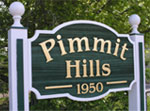(Or, how to get rid of that old chain link fence)
With many exceptions, a rickety, rusty, chain link fence, shored up by a leaning row of equally rusty posts, surrounds the typical PH property. Commonly, its length is entwined by vines, plants, and bushes, which either through neglect, decorative impulse, or perhaps some degree of shame, have been allowed to tangle themselves into a lush façade, hiding the corrosion beneath. Such was the case with my yard.
Until this spring I had spent almost a full year walking back and forth through my ugly, gate-less fences, mowing around each and every post, trimming back the vines that tenaciously tethered themselves through almost every section. All that time I wondered what utility they provided, unable to keep any pet or person out or in, and dissecting my lawn into two smaller uncooperative sections.
Finally, I marched outside in a spontaneous burst of impatient determination and gave my fences a long overdue “evil-eyeing”. Not only were they as useless as I suspected, but it also dawned on me that they were unnecessary.
Further inspection revealed that each section of chain link could be removed with nothing more than an adjustable wrench and perhaps one or two well-placed squirts of WD-40. I then gave each post a test tug and found that the loose, rain-soggy soil would make it quite easy for any physically able person to yank each post straight up and out of its place.
I soon brought up the subject with my landlord, and after a brief conversation about the cost I persuaded him that removing the fence would make his no-pet policy a near absolute certainty, and he soon called the appropriate person to put this new enforcement policy into effect.
The removal process was not without its snags. The truck, into which the fence was thrown, got stuck in my lawn and had to be pulled out by a considerate neighbor, after somewhat tearing up a few spots of grass. It occurred to us that we could also have simply dug out the top of each post anchor and cut the post off, then cover the concrete anchor with earth, leaving it to disappear from memory.
Thankfully, the damage wasn’t too deep, and I filled the shallow tire ruts and postholes in time for hearty spring grass to grow over them. Ever since, I have been thoroughly enjoying a surprising sense of lawn liberation.
I can walk in and out of my backyard in any place that is convenient, my front and back lawns now combine into a larger more useful area, and best of all, the unattractive, rusty fence is gone, and my property is more useful, enjoyable, it looks more appealing, uncluttered…and valuable.
From the perspective of work involved, the aesthetic benefits are well worth the effort, and I can only suggest that should a similar philosophy be adopted by the neighborhood in general, we will all find Pimmit Hills suddenly more lush and uncontained…bigger. Obviously, any existing fence that effectively serves some purpose for the tenant should be left to quietly do its job for another several decades.
I certainly do not question the presence of a particular section of my fences, particularly when my neighbors’ enormous Great Dane growls from the other crumbling side. Though he seems to be reasonably benevolent, I am quite in favor of maintaining this fence as a matter of chiropractic insurance.
But I have also seen fences so old and rusty that they are supported only by what has grown through them; keep an eye out for trees that have grown deformed around posts and fences that have long since fallen to pieces, and which would not otherwise be standing. In these cases, it would be an obvious compromise to simply remove any parts not engulfed in a trees’ wooden grip.
If you find yourself in a newer suburb, take a look around and see how a fence-less neighborhood seems roomier, newer, less restrained. If you’re reading this article at home, take a look out your window and consider what you would see without your chain link fence grating tiny crisscrosses on the lower half of your view.
Better yet, go outside, walk slowly around your home and consider how your property would change if you could erase some fences from the original builders’ blueprint. Stroll out to the street, slowly look your road up and down, and imagine how it might appear if we all de-fenced Pimmit Hills.
